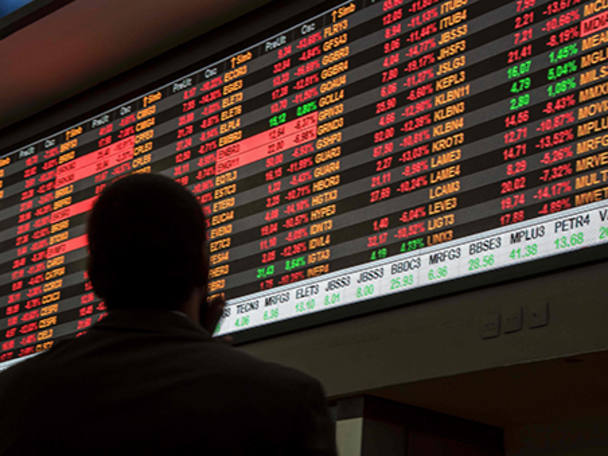If you're feeling nervous about stock market levels and anticipating a return of volatility in the coming months, you may have considered buying an exchange traded note (ETN) tracking the Chicago Board of Exchange Volatility Index(VIX).
The VIX index, also known as the 'fear index', is a measure of the market's expectation of the short-term volatility of the S&P 500 index of large-cap US equities, and uses the implied volatility of a range of S&P 500 options. The VIX's level represents the expected percentage range of movement of the S&P 500 over the next year so, for example, when the VIX is at 40 it means the majority of traders believe that the S&P 500 will remain within 40 per cent of its current level over the next year. It is expressed as a percentage of how much the price of the S&P 500 is expected to change, based on the rate of change in the price of options on the index.
The VIX index tends to rise when the S&P 500 falls and investors panic, and tends to fall when the S&P 500 rises. At present, the VIX is very low and in May fell to 9.6 - close to an all-time low. A level of 10 is psychologically significant, and many believe the VIX is out of step with the obvious headwinds facing the world. This also means that ETNs tracking the VIX index look cheap - a reason why some investors are considering buying them at the moment.
Oliver Smith, portfolio manager at IG, says: "The level of the VIX now would imply that the world is a very calm place and that the outlook is good, but traders believe that markets are looking very toppy and we're due a correction. So one way to hedge yourself against that and short the equity market would be to go long volatility."
Volatility ETNs
Investors expecting the S&P 500 to fall and or volatility to rise in the near term could invest in an ETN tracking the VIX index. And if they are also concerned about volatility in Europe they could invest in an ETN that tracks the VSTOXX index, which measures the 30-day implied volatility of the EURO STOXX 50 index.
There are five volatility ETNs listed on the London Stock Exchange. These are iPath S&P 500 VIX Mid-Term Future ETN (VXIM), iPath S&P 500 VIX Short-Term Future ETN, (VXIS) Boost S&P 500 VIX Short-Term Futures 2.25x Leverage Daily ETN VILX), iPath VSTOXX Mid-Term Futures ETN(VSXY) and iPath VSTOXX Short-Term Futures Total Return ETN (VSXG).
But volatility ETNs are not straightforward like plain vanilla tracker funds, which follow equity markets such as the FTSE All-Share or S&P 500.
Volatility ETNs may still shed money even if the indices bear out your predictions, because of the complex way they track volatility indices. "You cannot buy or sell the VIX index, you can only buy a VIX future quoted in Chicago," explains Peter Sleep, senior portfolio manager at Seven Investment Management. "The VIX is a future on the S&P 500 options market. So you are buying a future on a derivative of a derivative. As a future is a derivative, you are in derivative cubed territory."
The VIX index is made up of options contracts, so is a mathematical calculation rather than an index of stocks, meaning it cannot be tracked in the same way as conventional share indices. If you want to track the VIX you have to buy a futures contract based on those options.
This is not dissimilar to exchange traded commodities (ETCs), which track the spot prices of commodities by purchasing futures contracts. Because these ETCs buy futures rather than the actual commodity, their returns can differ wildly from the price of the assets they track. When you invest in an asset via futures, your returns do not mimic the current price of that asset due to the difference in cost between the futures price and current asset price. ETCs must continuously buy new futures contracts and, when prices are rising, that means continually selling the expiring contracts for less than the price of new ones, a phenomenon known as contango, which is detrimental to these funds' returns.
And this problem is amplified in VIX ETNs because the futures they buy are based on other derivatives, rather than a real asset such as commodity futures.
So, for example, between 31 May 2012 and 31 May 2017 the VIX index fell 48.3 per cent. But over the same period iPath S&P 500 VIX Short-Term Future ETN and iPath S&P 500 VIX Mid-Term Future ETN fell 98.8 per cent and 85.9 per cent, respectively. The VSTOXX index, meanwhile, fell 54.7 per cent between 31 May 2012 and 31 May 2017, over which period iPath VSTOXX Mid-Term Futures ETN lost 71.1 per cent and iPath VSTOXX Short-Term Futures Total Return ETN lost 94.31 per cent.
"Buying the VIX is a long-term loss making strategy because of the contango that is generally prevalent in the VIX futures market," says Mr Sleep.
At the moment contango is even sharper, because the market anticipates a rise in volatility. "And as the expectation is that volatility is going to rise, futures contracts are priced well above where the VIX spot price is," adds Mr Smith.
VIX and VSTOXX ETNs either buy short-term futures, which expire the soonest, or mid-term futures, which expire at a later date. Over the past three years, short-term futures ETNs have suffered the worst losses via contango, as futures contracts expiring soon have wider differences with the price of options.
For example, iPath S&P 500 VIX Short-Term Future ETN, which offers exposure to a daily rolling position in first and second month VIX futures contracts, has significantly underperformed iPath S&P 500 VIX Mid-Term Future ETN, which offers exposure to fourth, fifth, sixth and seventh month VIX futures contracts.
"Going long (buying) the VIX, you slowly bleed to death," says Mr Sleep. "Occasionally, you will enjoy a very large gain, but over time you will lose, despite those gains."
Index problems
The VIX and VSTOXX indices are unpredictable, and neither index is a measure of real S&P 500 or EURO STOXX 50 volatility. Rather they are an aggregation of traders' views of those markets in the future - a forward-looking estimation of volatility rather than its reality in the present.
So, for example, if the S&P 500 experiences a rise in volatility it doesn't mean the VIX index will too. In fact the VIX and VSTOXX tend to do the opposite of what the S&P 500 and EURO STOXX 50 do, so are most commonly used as a hedge against markets rather than a predictor of volatility.
The erratic nature of the VIX and VSTOXX indices means that they require frequent trading. "As the VIX trades erratically - it spikes then falls back very quickly - it is not commensurate with a buy and hold approach, meaning investors have to trade and rebalance their positions actively," explains Elizabeth Savage, head of research at Rathbones. That adds both cost and risk.
The riskiest volatility ETN is Boost S&P 500 VIX Short-Term Futures 2.25x Leverage Daily. Because this is leveraged, any movement in its returns are amplified, meaning that its investors' potential losses are also amplified. Boost S&P 500 VIX Short-Term Futures 2.25x Leverage Daily ETN was launched in March 2016, and between 30 June 2016 and 28 June 2017 lost 97.3 per cent.
But there are times when VIX and VSTOXX ETNs can beat their indices, such as when the indices they track are in the opposite state to contango, known as backwardation, and the ETNs profit from the falling price of futures contracts. About a year ago the VSTOXX index was briefly in backwardation, but this did not last long.
Mr Smith says: "If you bought a VIX ETN today and there was a political event in the US meaning that the S&P 500 sold off, for example by 5 per cent, it is likely that this would be a profitable trade. But the S&P 500 has not fallen by more than 2 per cent in over a month and the futures curve is getting steadily steeper, meaning that if a crash doesn't happen the consequences of holding on to a VIX ETN are becoming more painful.
"These types of ETN have been a very bad thing to hold until now, and investors should not buy them unless they are very, very clued up. If you think the market really is about to crash it would be better to take profits and hold cash, rather than buy a volatility ETN."
Performance of VIX and VSTOXX ETNs between 31.05.12 and 31.05.17
| ETN | Total return (%) |
|---|---|
| iPath S&P 500 VIX Mid-Term Future ETN | -85.86 |
| iPath S&P 500 VIX Short-Term Future ETN | -98.82 |
| VIX index | -48.25 |
| iPath VSTOXX Mid-Term Futures ETN | -71.1 |
| iPath VSTOXX Short-Term Futures Total Return ETN | -94.31 |
| VSTOXX index | -54.73 |
Source: Bloomberg Datastream, as at 28.06.17
Read more: Low-volatility ETFs can't keep winning










